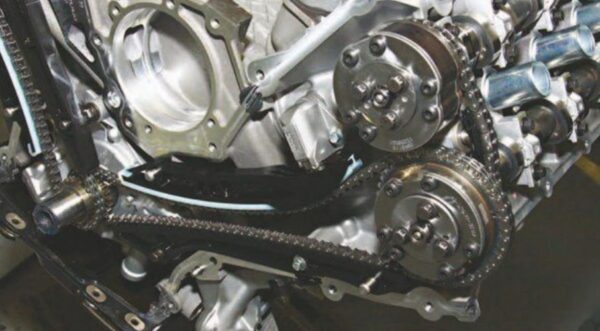Spark Knock? Coyote Rattle? What is this noise!?

Today, we talk about the Gen 3 Coyote "rattle" that is VERY commonly confused for spark knock. While this is more common on the Gen 3 engines, the phenomenon can occur with any generation of Coyote engine, and really, any engine that uses Variable Valve/Cam Timing.
First things first....
The robo-naration in this YouTube video is awful, but it does an excellent job of explaining how Ford's TiVCT system functions. Understanding how the system functions is integral to understanding the source of this noise. So, watch the video if you want to truly understand what's going on.
As for the noise, it isn’t spark knock. It’s a combination of several things, but it has nothing to do with spark knock. For one, spark knock wouldn’t be as loud as the noise these trucks typically make under these conditions. The only way spark knock would be audible on one of these engines would be if the knock sensors were completely non-functional. If that were the case there would be check engine lights on for the knock sensors being off-line. The knock sensors are MUCH more sensitive than human ears, and register possible engine knock well before it ever reaches the point of being audible.
The noise originates from the VCT system. It’s coming from the cam phasers and being transmitted through the timing chains and the rest of the timing components. The noise happens when oil pressure and flow to the cam phaser is not substantial enough to overcome the inertia of the cam rotation. Time stamp 1:40 in the video illustrates this really well.
The VCT system is attempting to apply oil pressure to the internal passage inside the cam phaser (vanes), and that pressure is what retards the cam timing in relation to the crankshaft rotation. If the oil pressure/flow is not substantial enough to overcome the force of the cam rotation. The oil will be pushed back out of the cam phaser and the oil will back-flow through the VCT solenoid. When this happens, the vanes inside of the cam phaser will “rattle” back and forth until oil pressure/flow is enough to overcome the rotational force of the cam. THIS is the source of the noise that everyone reports with these engines.
As mentioned, the noise occurs when the oil filling the voids in the phaser can’t overcome the force applied by the rotation of the cam and the oil is pushed back out of the void in the phaser and the vanes inside the phaser rattle. That noise can then be transmitted through all of the timing components, including the timing chains, causing the chains to "slap" against the timing chain guides.
This issue seems to be more prominent on Gen 3 engines versus Gen 1 and 2 engines. This is likely due to the stiffer valve springs that the Gen 3 engines use. Also, Gen 3 engines have a High-Pressure Fuel Pump (HPFP) for the direct injection system, that is driven off the passenger side exhaust cam. The HPFP and stiffer valve springs increase minimum force required to rotate the cam phasers, considerably, compared to older generation Coyote engines. That is one of the reasons this noise doesn't seem to be as prevalent in the previous engines. The evidence of the higher loads on the VCT phasers is also evident in the stock calibrations, as the Gen 3 engines require considerably higher duty cycles from the VCT solenoids to achieve similar degrees of cam retard, compared to Gen 1 and 2 engines.
The noise typically only happens at low RPM because the oil pump is a positive displacement design and can only displace a fixed volume of oil with each revolution. This means that to increase oil flow, volume, and pressure the pump requires more RPM. It should also be noted that pressure is a measurement of RESISTANCE, and in the case of an oiling system, it is a measurement of resistance to oil flow. Pressure increases when the total volume of oil flow exceeds the requirements of the engine. Meaning, the oil volume is sufficient to fill the voids in the engine left by things like bearing tolerances, cam journal tolerances, etc... and the oil system is meeting those requirements and providing a surplus of oil volume, and thus there is resistance to flow and pressure increases. This is why we expect oil pressure to increase with engine RPM. For those paying attention thus far... the light bulbs should be going off in your head. We've determined that the phaser rattle is caused by a lack of oil pressure/flow and now, we've also determined that oil pressure/flow is at it's lowest when engine RPM is low. Ding... ding... ding.... perfect recipe for cam phaser rattle. This is also why the noise is typically only heard for a split second on throttle tip-in, as right after that point oil pressure is able to meet the requirements to achieve the target cam angle and the rattle stops. However, the fact that the noise typically only happens on tip-in is one of the main reasons it's confused with spark knock.
Alright..... so now we've established the cause of the noise and we've covered how to stop the noise.... So how do we put this into practice? Well, we've already covered that increasing oil pressure will help with the issue. We know that increasing engine RPM will increase oil pressure, but how can we increase oil pressure if increasing engine RPM isn't an option?
The easiest way to do that is to run a heavier weight oil. The heavier weight oil will automatically increase oil pressure. Now, there is a limit. You can't go fill your engine with 90w gear oil and think everything is going to be fine.... as the trade off to heavier weight is a slight decrease in flow. So we have to balance the oil weight versus the engines oil flow requirements. That being said, this has been tested over and over in the Coyote engine, and it's been found that running up to 5w50 weight oil is safe and effective at increasing engine oil pressure. We use, and recommend 5w50 weight synthetic oil (please don't ask me for a specific brand, as I don't have one).
Also it is recommend to over-fill the oil pan by ½ quart, on any Coyote engine that is going to be ran hard. As most experienced Coyote engine builders will tell you, these engines have issues with oil drain-back under high load and RPM. Adding and additional 1/2 quart increases capacity to prevent oil starvation under extended load, put is not over-filled to the point that it could cause issues with windage. So, if you're running your truck hard, consider 5w50 and 1/2 quart overfilled.
To be VERY CLEAR.... I'm not saying that changing to 5w50 oil is magically going to make this noise go away. What I am saying is that it does help the cause of the issue, and for some it has pretty much resolved the noise.
LOOOONNNGGGG story short, the noise is not spark knock. Running heavier weight oil can improve the issue, but is not a "fix". There are tuning changes that can be made, which we've been including in our tunes for a long time now, that also can improve the issue, but at the end of the day... while it is annoying, Ford doesn’t consider it detrimental to the health of the engine. So, take that for what it's worth to you.
Ken Osborne - Owner Oz Tuning, LLC.

